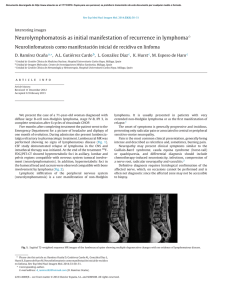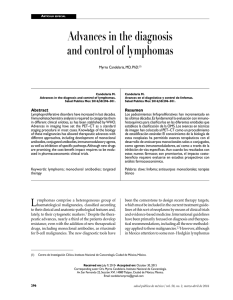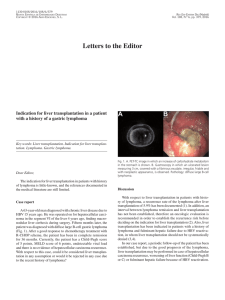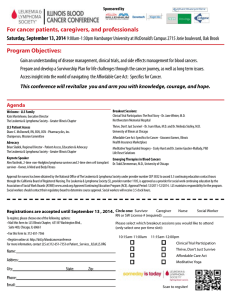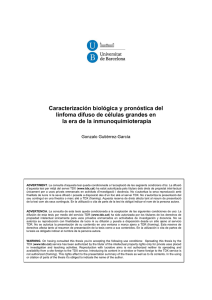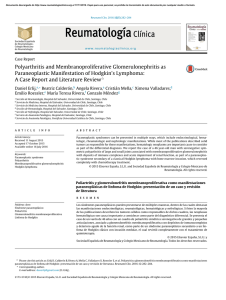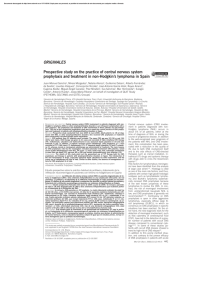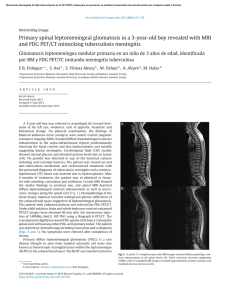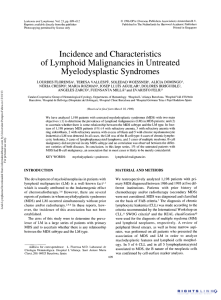Diffuse large B-cell lymphoma of the oral cavity
Anuncio
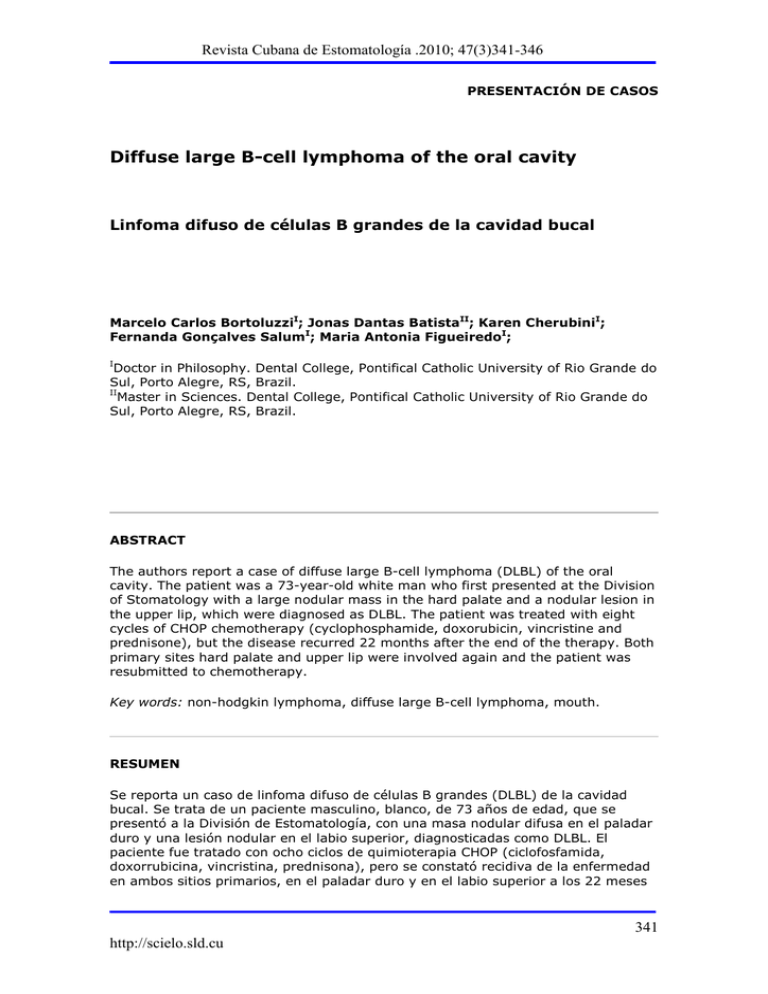
Revista Cubana de Estomatología .2010; 47(3)341-346 PRESENTACIÓN DE CASOS Diffuse large B-cell lymphoma of the oral cavity Linfoma difuso de células B grandes de la cavidad bucal Marcelo Carlos BortoluzziI; Jonas Dantas BatistaII; Karen CherubiniI; Fernanda Gonçalves SalumI; Maria Antonia FigueiredoI; I Doctor in Philosophy. Dental College, Pontifical Catholic University of Rio Grande do Sul, Porto Alegre, RS, Brazil. II Master in Sciences. Dental College, Pontifical Catholic University of Rio Grande do Sul, Porto Alegre, RS, Brazil. ABSTRACT The authors report a case of diffuse large B-cell lymphoma (DLBL) of the oral cavity. The patient was a 73-year-old white man who first presented at the Division of Stomatology with a large nodular mass in the hard palate and a nodular lesion in the upper lip, which were diagnosed as DLBL. The patient was treated with eight cycles of CHOP chemotherapy (cyclophosphamide, doxorubicin, vincristine and prednisone), but the disease recurred 22 months after the end of the therapy. Both primary sites hard palate and upper lip were involved again and the patient was resubmitted to chemotherapy. Key words: non-hodgkin lymphoma, diffuse large B-cell lymphoma, mouth. RESUMEN Se reporta un caso de linfoma difuso de células B grandes (DLBL) de la cavidad bucal. Se trata de un paciente masculino, blanco, de 73 años de edad, que se presentó a la División de Estomatología, con una masa nodular difusa en el paladar duro y una lesión nodular en el labio superior, diagnosticadas como DLBL. El paciente fue tratado con ocho ciclos de quimioterapia CHOP (ciclofosfamida, doxorrubicina, vincristina, prednisona), pero se constató recidiva de la enfermedad en ambos sitios primarios, en el paladar duro y en el labio superior a los 22 meses 341 http://scielo.sld.cu Revista Cubana de Estomatología .2010; 47(3)341-346 después del término de la terapia. El paciente fue sometido de nuevo a la quimioterapia. Palabras clave: No-Hodgkin linfoma, linfoma B de células grandes difuso, cavidad oral. INTRODUCTION Lymphomas are malignant neoplasms arisen from lymphocytes (B or T) that affect mainly lymph nodes, spleen, and other non-hematopoietic tissues. They are classified as Hodgkin´s lymphoma or non-Hodgkin´s lymphoma.1 Diffuse large Bcell lymphoma (DLBL) is the most common variant of non-Hodgkin´s intermediategrade lymphomas, and frequently involves extranodal sites. Even though DLBL is characterized by an aggressive behavior, it responds favorably to chemotherapy.2 Non-Hodgkin´s lymphomas are usually manifested as localized or generalized lymphadenopathy. However, the primary lesion can occur in other sites, principally where lymphoid tissue is present such as oropharynx, intestine, bone marrow and skin.3 DLBL is often associated with systemic symptoms such as night sweats, weight loss and fever. In the oral soft tissues, lesions can occur as hard and diffuse tumors involving oral vestibule, gums and the posterior region of the hard palate. In bone tissue, they may cause mild pain, paresthesia and swelling; the radiographic examination often shows irregular radiolucid images. DLBL corresponds to 68% of cases of non-Hodgkin's lymphoma of the oral cavity and the average age of highest prevalence is 66 years.4 Women are more affected than men in a 2:1 ratio.3 Most lymphomas, including DLBL, arise from B cells and are characterized histologically by diffuse population of large cells with oval nucleus, cleaved or not. Multiple nucleoli are seen adjacent to a thick nuclear membrane; large quantities of cells with clear cytoplasm and mitoses are easily observed; and focal necrosis may also occur.3-5 It is advisable to complement the histological diagnosis by immunohistochemistry, which facilitates the classification of these tumors.6,7 Rosenwald et al.2 used the gene-expression profiles of DLBL to develop a molecular predictor of survival. The authors emphasize the importance of molecular diagnosis in this type of lymphomas. According to them, DLBL molecular features vary widely and, for this reason, individualized and molecularly targeted therapies are required. The accuracy of the diagnosis is crucial to the efficacy of the therapy.8 The main treatment for DLBL is chemotherapy, whose protocols can present great efficiency. Using anthracyclin-based therapy (CHOP) alone, the cure can be achieved in 35% to 40% of patients. Moreover, aiming to increase the efficacy of chemotherapy other drugs such as rituximab can also be associated. Radiotherapy and surgery are reported as adjuvant therapies as well.2,9-12 CASE REPORT 342 http://scielo.sld.cu Revista Cubana de Estomatología .2010; 47(3)341-346 A 73-year-old white man complaining of a painless swelling in the hard palate under the upper removable denture was referred to Division of Stomatology of São Lucas Hospital-PUCRS. The lesion had started three months before, no previous sign or symptoms were reported and there was no relevant medical history. Oral examination revealed two nodular lesions: one in the hard palate, with firm consistency and erythematous overlying mucosa (Fig. 1); and the other one in the upper left lip measuring 2.5 cm in diameter, erythematous and firm to palpation (Fig. 2). The patient also presented with submandibular lymphadenopathy. Occlusal and panoramic radiographic examinations did not show any relevant change. The clinical diagnostic hypotheses were lymphoma and neoplasm of salivary gland. The hematological tests (complete blood count, fasting blood glucose, prothrombin time, partial thromboplastin time, erythrocyte sedimentation rate, anti-HIV) were normal and the incisional biopsy of both lesions was performed. The histological diagnosis was diffuse large cell lymphoma (Fig. 3). Immunohistochemical panel showed the following results: Bcl2 positive; CD10 (calla) negative; CD20 (B cells) positive; CD45RO (T cells) focal-positive; CD3 (T cells) focal-positive; CD30 negative; CD15 negative; CD5 focal-positive. The immunohistochemical evaluation confirmed the diagnosis of B-cell lymphoma. The patient was treated by 343 http://scielo.sld.cu Revista Cubana de Estomatología .2010; 47(3)341-346 chemotherapy with cyclophosphamide, doxorubicin, vincristine and prednisone (CHOP regimen). Elapsed 22 months after chemotherapy, both lesions recurred and were biopsied again. The histological examination confirmed the clinical diagnosis of recurrence of DLBL, and the patient was referred to the Department of Oncology for new cycles of chemotherapy. DISCUSSION Lymphoma classification is controversial, with several changes proposed in the past decades. The original classification of Rappaport, at the beginning of the 60s, was based on the pattern of tumor growth observed in a lymph node (nodular or diffuse). However, the modern classification incorporated both morphological and immunological features and, recently, also molecular and genetic ones.4,13,14 Non-Hodgkin's lymphoma represents a diverse and complex group of malignant neoplasms of lymphoreticular histogenesis and can be grouped into three histological categories: low, intermediate and high grades, according to the aggressiveness and prognosis. DLBL is classified as a B-cell lymphoma of intermediate grade, and among the lymphomas, shows the highest prevalence in the oral cavity.3 This neoplasm accounts for approximately 30 % - 58 % of cases of non-Hodgkin´s lymphomas, and the incidence increase with age from 0.3/100,000/year (35-39 years) to 26.6/100,000/year (80-84 years).6 Recent molecular studies evidenced that chromosomal abnormalities play an important role in the pathogenesis of the disease and its sub-classification is important to guide the treatment.8,13,15 The standard treatment for patients with diffuse large-B-cell lymphoma is cyclophosphamide, doxorubicin, vincristine, and prednisone (CHOP). Nevertheless, with a projected disease-free survival rate of 36 %, it is far from ideal therapy, and there is a need for better treatment approaches.16 Even though, when cure is not possible, this treatment is capable of controlling the disease for many years. Further chemotherapy can often be given if the lymphoma comes back after initial treatment.11,13 This article reports the case of a patient with oral non-Hodgkin's lymphoma, in which CHOP regimen of chemotherapy was not efficacious, as the disease recurred 344 http://scielo.sld.cu Revista Cubana de Estomatología .2010; 47(3)341-346 22 months later. However, it is important to consider that the lesion was a clinical stage II according to the classification of the Conference of Ann Arbor modified by Carbone,4 which indicates higher aggressiveness. CONCLUSIONS DLBL is the most common lymphoma affecting oral cavity, and deserves the attention of professionals. The diagnosis may be challenging because of the lack of symptoms, which lead to misdiagnosis and delayed treatment. The recognition of clinical manifestations of this disease in oral cavity is important. Efforts should be made to diagnose this disease as soon as possible, since the prognosis is directly related to the disease staging at the patient admission. An interesting point that cannot be neglected is the ability of recurrence of DLBL, which makes the follow-up of these patients indispensable. REFERENCES 1. Epstein JB, Epstein JD, Le ND, Gorsky M. Characteristics of oral and paraoral malignant lymphoma: a population-based review of 361 cases. Oral Surg Oral Med Oral Pathol Oral Radiol Endod. 2001;92(5):519-25. 2. Rosenwald A, Wright G, Chan WC, Connors JM, Campo E, Fisher RI, et al. The use of molecular profiling to predict survival after chemotherapy for diffuse large-Bcell lymphoma. N Engl J Med. 2002;346(25):1937-47. 3. Solomides CC, Miller AS, Christman RA, Talwar J, Simpkins H. Lymphomas of the oral cavity: histology, immunologic type, and incidence of Epstein-Barr virus infection. Hum Pathol. 2002;33(2):153-7. 4. Kotylo PK, Gatzimoset K, Krause J. Lymphoproliferative disorders. In: Rodak, BF, ed. Diagnostic Hematology. Philadelphia: WB Saunders, 1995:373-89. 5. Handlers JP, Howell RE, Abrams AM, Melrose RJ. Extranodal oral lymphoma. Part I. A morphologic and immunoperoxidase study of 34 cases. Oral Surg Oral Med Oral Pathol. 1986;61(4):362-7. 6. Tilly H, Dreyling M; ESMO Guidelines Working Group. Diffuse large B-cell nonHodgkin's lymphoma: ESMO Clinical Practice Guidelines for diagnosis, treatment and follow-up. Ann Oncol. 2010;21(Suppl 5):v172-4. 7. Armitage JO. How I treat patients with diffuse large B-cell lymphoma. Blood. 2007;110(1):29-36. 8. Magrath, I. Molecular characteristics of diffuse large-B-cell lymphoma. N Engl J Med. 2002;346(25):1998-9. 9. Pfreundschuh M, Trümper L, Österborg A, Pettengell R, Trneny M, Imrie K, et al. CHOP-like chemotherapy plus rituximab versus CHOP-like chemotherapy alone in young patients with good-prognosis diffuse large-B-cell lymphoma: a randomised 345 http://scielo.sld.cu Revista Cubana de Estomatología .2010; 47(3)341-346 controlled trial by the Mab Thera International Trial (MInT) group. Lancet Oncol. 2006;7(5):379-91. 10. Goda JS, Gospodarowicz M, Pintilie M, Wells W, Hodgson DC, Sun A, et al. Long-term outcome in localized extranodal mucosa-associated lymphoid tissue lymphomas treated with radiotherapy. Cancer. 2010 (In press). doi: 10.1002/cncr.25226. 11. Rigacci L, Fabbri A, Puccini B, Chitarrelli I, Chiappella A, Vitolo U, et al. Oxaliplatin-based chemotherapy (dexamethasone, high-dose cytarabine, and oxaliplatin) +/- rituximab is an effective salvage regimen in patients with relapsed or refractory lymphoma. Cancer 2010. (In press). doi: 10.1002/cncr.25216. 12. Schmits R, Schmitz N, Pfreundschuh M, German High-Grade Non-Hodgkin's Lymphoma Study Group. The best treatment for diffuse large B-cell lymphoma: a German perspective. Oncology. (Williston Park) 2005;19(4 Suppl 1):16-25. 13. Papajík T, Jedlicková K, Kriegová E, Jarosová M, Raida L, Faber E, et al. Polymerase chain reaction detection of cell carrying t(14;18) in bone marrow of patients with follicular and diffuse large-Bcell lymphoma: the importance of analysis at diagnosis and significance of long-term follow-up. Neoplasma. 2001;48(6):5015. 14. Shaknovich R, Geng H, Johnson NA, Tsikitas L, Cerchietti L, Greally JM, et al. DNA methylation signatures define molecular subtypes of diffuse large B cell lymphoma. Blood. 2010 (In press). doi 10.1182/blood-2010-05-285320. 15. Staudt LM, Dave S. The biology of human lymphoid malignancies revealed by gene expression profiling. Adv Immunol. 2005;87:163-208. 16. Fisher RI, Miller TP, O'Connor OA. Diffuse aggressive lymphoma. Hematology Am Soc Hematol Educ Program. 2004:221-36. Recibido: 5 de marzo de 2010. Aprobado: 10 de abril de 2010. Dr. Karen Cherubini. Serviço de Estomatologia. Hospital São Lucas PUCRS, CEP 90610-000. Porto Alegre, RS, Brazil. E-mail: karen.cherubini@pucrs.br; kebini.ez@terra.com.br 346 http://scielo.sld.cu
